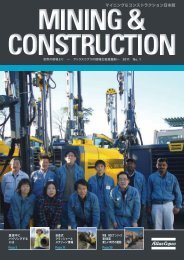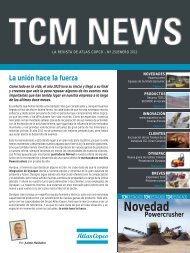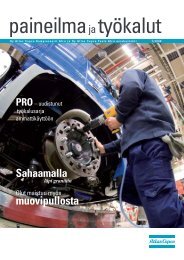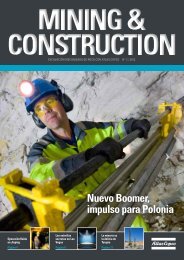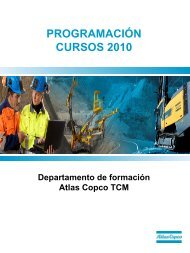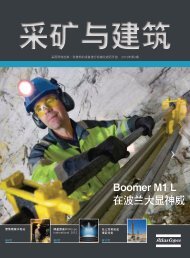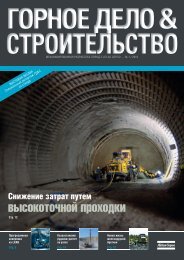World record for raiseboring - Atlas Copco
World record for raiseboring - Atlas Copco
World record for raiseboring - Atlas Copco
- No tags were found...
Create successful ePaper yourself
Turn your PDF publications into a flip-book with our unique Google optimized e-Paper software.
TECHNICALLY SPEAKING >>>>>>>>>>>>>>>>>>>>>>>>>>>>>>>>>>>>>>>>>>>>>>>>>>>>>>>>>>>>>>>>>>>>>>>>>>>>>>>>>>>>>>>>>>>>>>>>>>>>>>>>>>>>>>>>>>>>>The competitive EDGEin DTH deep hole drillingNow drillers can really tell what goes on inside the holeMore than two years of research has resulted in a major advance in deephole drilling efficiency. Called EDGE, this system (patents pending worldwide)provides deep hole drillers using DTH equipment with the eyes and ears theyneed at the bottom of the hole.One of the biggest challenges that constantlyfaces deep hole drillers is howto predict the changes that take placeat the bottom of the hole during drilling,especially at depths of 100 meters or more.Traditionally, the driller’s competence,based on years of experience and oftena special talent or “sixth sense” enablesassumptions to be made with a high degreeof accuracy. But at the end of the day, theseassumptions are educated guesses.About two years ago, we, together withour development partner SPC Technology,decided to try and do better than guesswork.We wanted to find out if it would be possiblenot just to predict, but to actually see whatgoes on at the bottom of the hole.Now we know. Not only can we see thesechanges, we can see them instantly thanksto EDGE, the world’s first system <strong>for</strong> continuousdeep hole monitoring.EDGE can be fitted to all types of deephole drill rigs that use Secoroc’s DTH(down-the-hole) hammers. It consists of asensor, a data capturing and processing unit– the brain of the system – and a rugged PCwith a 7-inch display screen (Fig 1).How EDGE worksThe sensor is mounted on the drill head orrotation unit and connected by a cable to thedata capturing unit mounted on the mast orrig. The display PC is mounted next to thedrill controls at eye level so that it can beeasily seen by the operator.The process starts immediately when thepiston in the DTH hammer strikes the bit,creating vibration. The vibration is captured,processed and interpreted and the data istransmitted to the PC where it is displayedboth graphically and in numbers (Fig 2). Anyunexpected changes that occur at the bottomof the hole are displayed in real timeand early warnings alert the operator to anyoccurence that might have a negative impacton the drilling process or cause damage tothe equipment (Fig 3).The graphic “spikes” can be interpretedas representing different in-hole scenariossuch as the sudden presence of a new typeof rock or geological zone. This immediateand continuous feedback enables thedriller to continuously optimize the drillingprocess.No more “blind” drillingAimed primarily at the oil and gas industrieswhere the majority of deep hole drillersare at work, it enables drillers to followthe drilling process in real time and tomake continuous adjustments to the feed<strong>for</strong>ce, rotation speed and so on, in order tooptimize the drilling of a hole from startto finish.In other words, it means the driller willno longer be drilling “blind”, eliminatingthe fear that something unexpected may behappening that could hinder progress, oreven require stopping the rig and removingthe drillstring altogether, an operation thatcould take two or three days, significantlyreducing productivity and increasing costs.It could be that the rock drill suddenlyencounters a new type of <strong>for</strong>mation thatthreatens to “shank” the bit. Perhaps thehole is not cleaning properly and the drillstring is in danger of jamming. Or perhapsa slight vibration caused by movementinside the chuck as a result of insufficientfeed <strong>for</strong>ce, is gradually reducing the cuttingcapacity. Whatever the scenario, the earlierthe driller knows about it and takes preventiveaction, the better it will be.New dimensionIn this way, EDGE brings a whole newdimension to the deep hole drilling industry,and not least <strong>for</strong> those engaged in horizontaldrilling such as in the huge oil and gas fieldsof the United States where equipment loss,trouble-shooting and maintenance representa major portion of the investment.Obvious benefits are continuous highproductivity and improved overall economythrough increased penetration rate, improvedequipment life and reliability, lessfuel consumption and lower costs. But thereare other benefits too that are important.Not only does EDGE enhance the skillof experienced drillers, it also substantiallyreduces the time it takes to get new drillersup to speed as they do not need years ofexperience to learn to identify what’s goingon in the hole by “watching and listening”.A typical exampleIn Sweden, it normally takes about six toeight months to train a driller up to proficiencystandard. Using the EDGE system,our Swedish customers are cutting thistraining time drastically. A typical exampleis the deep hole drilling specialist SYDABwhich recently trained a <strong>for</strong>mer truck driverup to drilling proficiency standard in just afew weeks. Furthermore, the company has18 MINING & CONSTRUCTION – 1 / 2011




